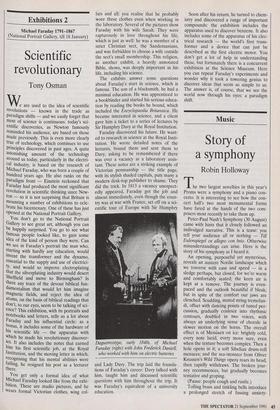Exhibitions 2
Michael Faraday 1791-1867 (National Portrait Gallery, till 18 January)
Scientific revolutionary
Tony Osman
are used to the idea of scientific revolutions — known in the trade as paradigm shifts — and we easily forget that most of science is continuous: today's sci- entific discoveries, as Newton famously reminded his audience, are based on those made previously. This is even more clearly true of technology, which continues to use principles discovered in past ages. A quite astonishing amount of the technology around us today, particularly in the electri- cal industry, is based on the research of Michael Faraday, who was born a couple of hundred years ago. He also ranks on the paradigm front — Einstein reckoned that Faraday had produced the most significant revolution in scientific thinking since New- ton — so it is not surprising that Britain is mounting a number of exhibitions to cele- brate his bicentenary. One of these has just opened at the National Portrait Gallery.
You don't go to the National Portrait Gallery to see great art, although you can be happily surprised. You go to see what famous people looked like, to gain some Idea of the kind of person they were. Can we see in Faraday's portrait the man who, starting with hardly any education, would Invent the transformer and the dynamo, essential to the supply and use of electrici- ty, and would so improve electroplating that the silverplating industry would desert Sheffield and move to Birmingham? Is there any trace of the devout biblical fun- damentalism that would let him imagine magnetic fields, and reject the idea of atoms, on the basis of biblical readings that don't, to our eyes, seem to be talking of sci- ence? This exhibition, with its portraits and notebooks and letters, tells us a lot about Faraday and his influential circle: as a bonus, it includes some of the hardware of his scientific life — the apparatus with which he made his revolutionary discover- ies. It also includes the notes that earned him his first scientific job, at the Royal Institution, and the moving letter in which, recognising that his mental abilities were failing, he resigned his post as a lecturer there.
You get only a formal idea of what Michael Faraday looked like from the exhi- bition. These are studio pictures, and he wears formal Victorian clothes, wing col-
lars and all: you realise that he probably wore these clothes even when wbrking in the laboratory. Several of the pictures show Faraday with his wife Sarah. They were rapturously in love throughout his life, which is just as well: he was a member of a strict Christian sect, the Sandemanians, and was forbidden to choose a wife outside the sect's small membership. This religion, as another exhibit, a heavily annotated Bible, shows, was deeply important in his life, including his science.
The exhibits answer some questions about Faraday's start in science, which is famous. The son of a blacksmith, he had a minimal education. He was apprenticed to a bookbinder and started his serious educa- tion by reading the books he bound, which included the Encyclopaedia Britannica. He became interested in science, and a client gave him a ticket to a series of lectures by Sir Humphry Davy at the Royal Institution. Faraday discovered his future. He want- ed to research in science at the Royal Insti- tution. He wrote detailed notes of the lectures, bound them and sent them to Davy, asking to be remembered if there was ever a vacancy as a laboratory assis- tant. These notes are a striking example of Victorian penmanship — the title page, with its stylish shaded capitals, puts many a modern desk-top publisher to shame. They did the trick. In 1813 a vacancy unexpect- edly appeared, Faraday got the job and almost immediately, even though the coun- try was at war with France, set off on a sci- entific tour of Europe with Sir Humphry Daguerreotype, early 1840s, of Michael Faraday (right) with John Frederick Daniell, who worked with him on electric batteries and Lady Davy. The trip laid the founda- tions of Faraday's career: Davy talked with him, taught him and discussed scientific questions with him throughout the trip. It was Faraday's equivalent of a university education. Soon after his return, he turned to chem- istry and discovered a range of important compounds: the exhibition includes the apparatus used to discover benzene. It also includes some of the apparatus of his elec- trical research — the world's first trans- former and a device that can just be described as the first electric motor. You don't get a lot of help in understanding these, but fortunately there is a concurrent exhibition at the Science Museum. Here you can repeat Faraday's experiments and wonder why it took a towering genius to discover ideas that seem so simple to us. The answer is, of course, that we see the world now through his eyes: a paradigm shift.


























































 Previous page
Previous page